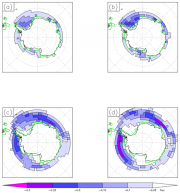Sea ice change over the 21st century
- This page is part of the topic Antarctic climate and environment change over the next 100 years
The average of the CMIP3 model’s sea ice extent compares well with observations, although there is a large inter-model spread (Arzel et al., 2006[1]; Parkinson et al., 2006[2]).
Models following the A1B scenario show that over the Twenty First Century the annual average total sea ice area is projected to decrease by 2.6 × 106 km2, or 33% (Bracegirdle et al., 2008[3]). There is strong consensus among the models for an Antarctica-wide decrease in sea ice; the inter-model standard deviation is low at 0.73 × 106 km2 (9%). Arzel et al. (2006[1]) assessed different measures of sea ice amount using a different subset of 15 of the CMIP3 A1B projections and found Twenty First Century deceases of 34% for sea-ice volume and 24% for sea-ice extent.

Most of the simulated ice retreat occurs in winter and spring when the sea ice extent is largest (Figure 5.16). The amplitude of the seasonal cycle of sea ice area will therefore decrease. The smaller amount of seasonal ice melting/freezing will affect the ocean due to changes in processes such as brine rejection.
There is strong confidence in the projected Antarctic-wide decreases of sea ice extent. At a more regional level, decreases of sea ice are less significant (e.g. Lefebvre and Goosse, 2008[4]). One way to measure the significance of a projected change is to calculate the signal to noise ratio of that change. Here the signal is the ensemble average change, and the noise is the standard deviation of the inter-model spread. A change can be thought of as ‘significant’ if larger than the inter-model standard deviation, i.e. a signal to noise ratio of greater than one. In the regions where sea ice currently remains present throughout the summer, in particular the Weddell Sea, large reductions of sea ice extent are projected. On this there is quite a strong consensus between the models, with the model average reductions larger than the inter-model standard deviation (Figure 5.16). However, at the scale of one grid point the confidence of a reduction of sea ice over the Twenty First Century is not significant in many regions (i.e. the magnitude of the change is smaller than one standard deviation of the inter-model spread).
References
- ↑ 1.0 1.1 Arzel, O., Fichifet, T. and Goosse, D.H. 2006. Sea ice evolution over the 20th and 21st centuries as simulated by current AOGCMs. Ocean Modelling, 12, 401-415.
- ↑ Parkinson, C.L., Vinnikov, K.Y. and Cavalieri, D.J. 2006. Evaluation of the simulation of the annual cycle of Arctic and Antarctic sea ice coverages by 11 major global climate models, J. Geophys. Res., 111, doi:10.1029/2005JC003408.
- ↑ Bracegirdle, T.J., Connolley, W.M. and Turner, J. 2008. Antarctic climate change over the Twenty First Century, Journal of Geophysical Research – Atmospheres, 113, D03103, doi:03110.01029/02007JD008933.
- ↑ Lefebvre, W. and Goosse, H. 2008. Analysis of the projected regional sea-ice changes in the Southern Ocean during the twenty-first century, Climate Dynamics, 30, 59-76, DOI 10.1007/s00382-007-0273-6.